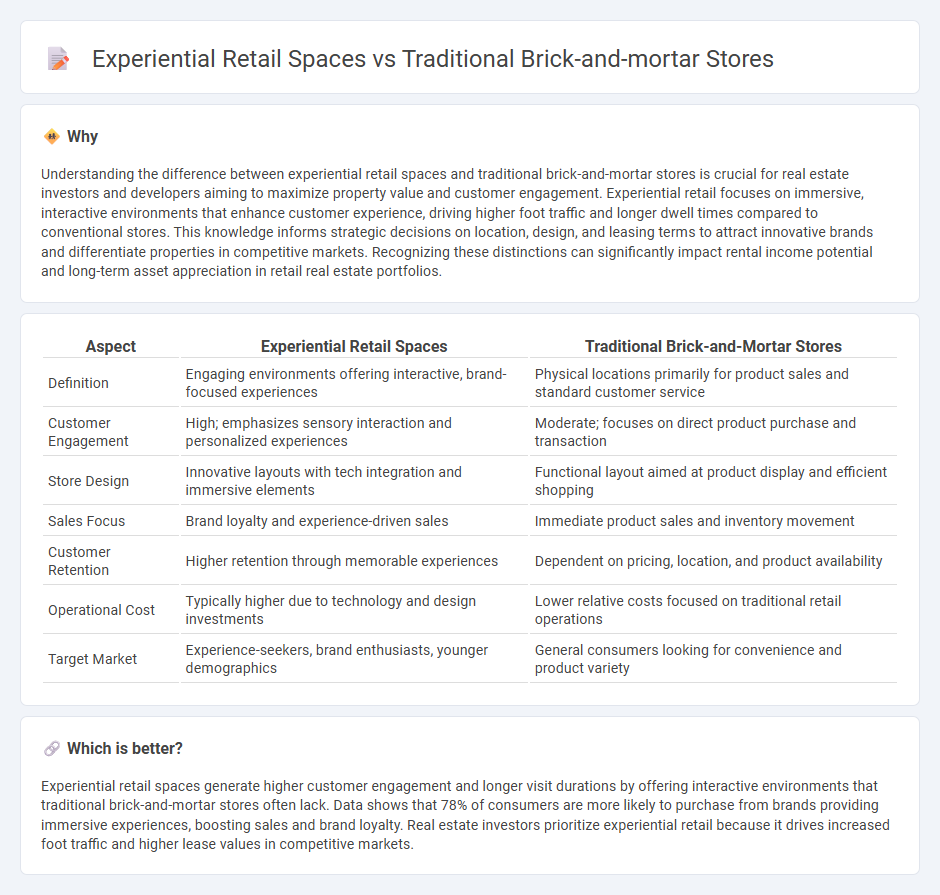
Experiential retail spaces blend immersive, sensory-driven environments with shopping, focusing on customer engagement and brand interaction, contrasting with traditional brick-and-mortar stores that prioritize product display and transactional efficiency. These innovative spaces leverage technology and design to create memorable experiences, driving foot traffic and increasing dwell time for retailers in competitive markets. Discover how experiential retail is transforming real estate strategies and consumer behavior in the retail sector.
Why it is important
Understanding the difference between experiential retail spaces and traditional brick-and-mortar stores is crucial for real estate investors and developers aiming to maximize property value and customer engagement. Experiential retail focuses on immersive, interactive environments that enhance customer experience, driving higher foot traffic and longer dwell times compared to conventional stores. This knowledge informs strategic decisions on location, design, and leasing terms to attract innovative brands and differentiate properties in competitive markets. Recognizing these distinctions can significantly impact rental income potential and long-term asset appreciation in retail real estate portfolios.
Comparison Table
| Aspect | Experiential Retail Spaces | Traditional Brick-and-Mortar Stores |
|---|---|---|
| Definition | Engaging environments offering interactive, brand-focused experiences | Physical locations primarily for product sales and standard customer service |
| Customer Engagement | High; emphasizes sensory interaction and personalized experiences | Moderate; focuses on direct product purchase and transaction |
| Store Design | Innovative layouts with tech integration and immersive elements | Functional layout aimed at product display and efficient shopping |
| Sales Focus | Brand loyalty and experience-driven sales | Immediate product sales and inventory movement |
| Customer Retention | Higher retention through memorable experiences | Dependent on pricing, location, and product availability |
| Operational Cost | Typically higher due to technology and design investments | Lower relative costs focused on traditional retail operations |
| Target Market | Experience-seekers, brand enthusiasts, younger demographics | General consumers looking for convenience and product variety |
Which is better?
Experiential retail spaces generate higher customer engagement and longer visit durations by offering interactive environments that traditional brick-and-mortar stores often lack. Data shows that 78% of consumers are more likely to purchase from brands providing immersive experiences, boosting sales and brand loyalty. Real estate investors prioritize experiential retail because it drives increased foot traffic and higher lease values in competitive markets.
Connection
Experiential retail spaces enhance traditional brick-and-mortar stores by creating immersive environments that drive customer engagement and increase foot traffic. Integrating sensory elements and interactive technology transforms shopping from a transactional activity into a memorable experience, boosting brand loyalty and sales. Real estate developers and retailers collaborate to design these hybrid spaces, optimizing location value and adapting to evolving consumer preferences.
Key Terms
Foot Traffic
Traditional brick-and-mortar stores maintain steady foot traffic through established locations and convenience, attracting regular local customers familiar with their presence. Experiential retail spaces drive increased foot traffic by offering immersive, interactive environments that encourage longer visits and social sharing, appealing particularly to younger, experience-seeking demographics. Explore how these retail strategies can optimize your store's foot traffic and customer engagement.
Tenant Mix
Traditional brick-and-mortar stores typically emphasize a tenant mix dominated by established brands and essential retailers that drive consistent foot traffic and sales volume. Experiential retail spaces prioritize diverse tenants offering interactive, immersive, and lifestyle-driven experiences that attract consumers seeking engagement beyond mere shopping. Explore how optimizing tenant mix strategically enhances consumer engagement and boosts overall retail performance.
Store Layout
Traditional brick-and-mortar stores often prioritize straightforward, product-focused layouts to maximize merchandise visibility and streamline shopping flow, while experiential retail spaces emphasize immersive design elements and interactive zones that engage customers emotionally and create memorable experiences. Effective store layout in experiential retail integrates technology, sensory stimuli, and flexible spaces to encourage exploration and social interaction, moving beyond mere transaction. Discover how innovative store layouts are transforming retail environments and boosting customer loyalty.
Source and External Links
What Is a Brick and Mortar Store? Top 10 Retail Examples - This article explains that brick-and-mortar stores are traditional retail businesses operating from physical locations, providing hands-on shopping experiences and contributing to local economies.
Brick-and-Mortar: Different Types of Physical Retail Stores - This page describes brick-and-mortar stores as conventional businesses with physical retail locations where customers can browse and purchase products in person, contrasting them with online retailers.
Brick and Mortar Stores: Types, Benefits, Examples (2024) - This resource outlines the definition and benefits of brick-and-mortar stores, including their role as hubs for omnichannel retail experiences like in-store events and pick-up services.
 dowidth.com
dowidth.com